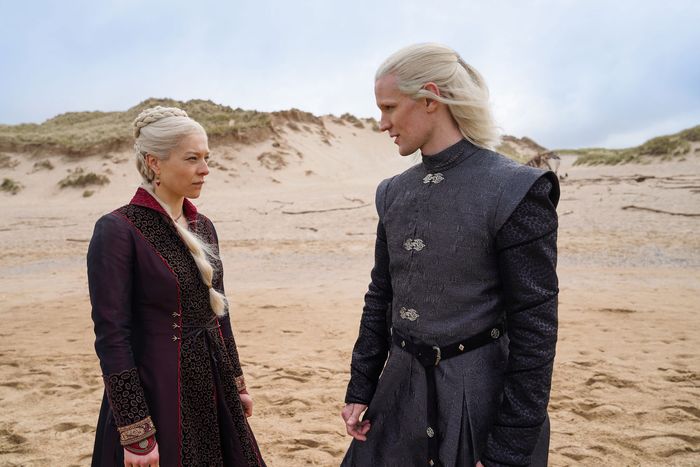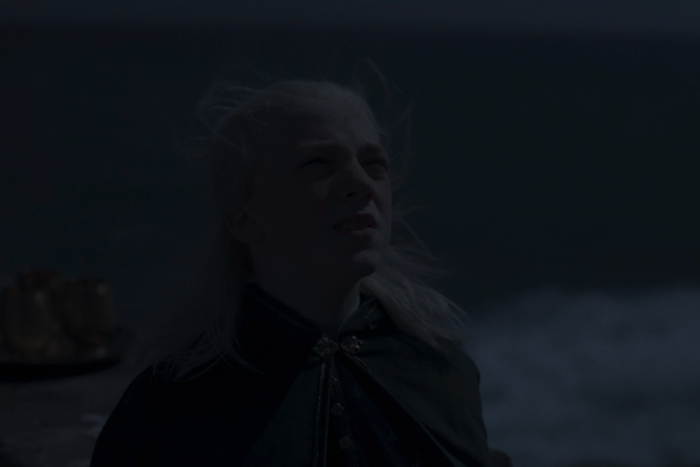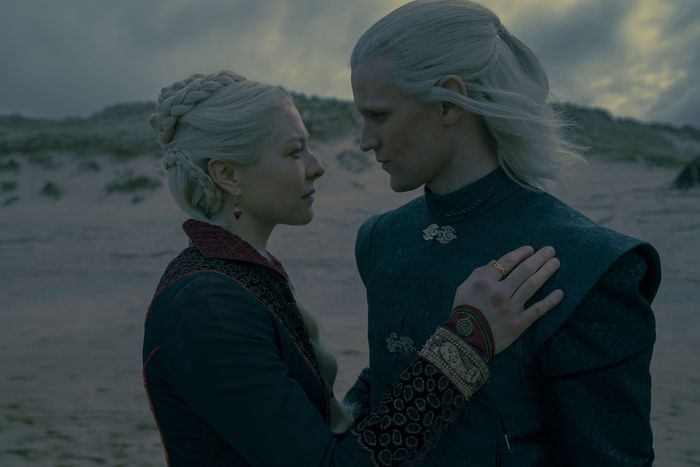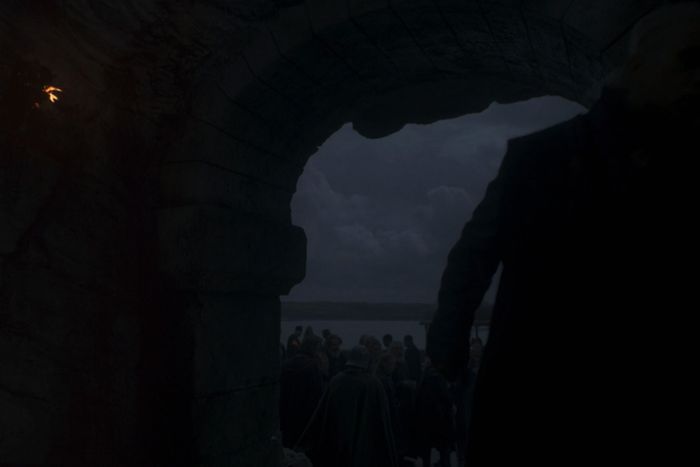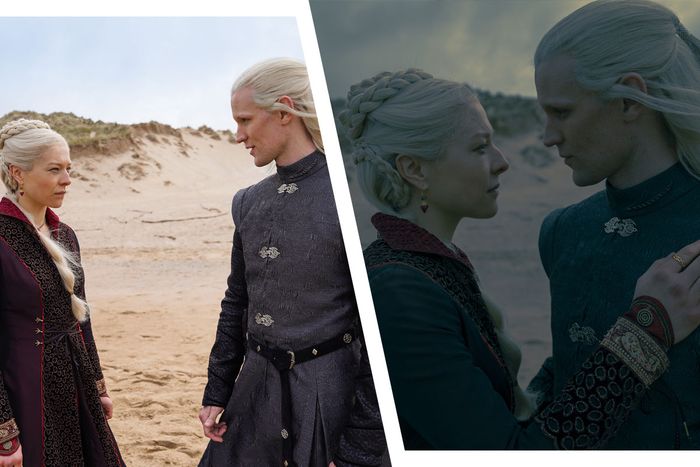
There’s a set of scenes in episode seven of House of the Dragon in which two illicit, momentous things happen. In one, Rhaenyra Targaryen has sex with her uncle Daemon and is so enthralled and moved by the experience that they later decide to get married. In the other, which is intercut with all the sexy incest, Aemond Targaryen sneaks across the beach and climbs on top of Vhagar, a very old and powerful dragon that belonged to his now-deceased aunt. Aemond goes on a successful dragon flight, claiming Vhagar for himself rather than letting his mourning cousins inherit their mother’s dragon.
I’m explaining this to you because chances are good that even if you watched this episode yourself — even if you sat in front of a large television in a darkened room, carefully avoiding your phone screen and closing the blinds to cut out any street glare — it’s likely you could not see a single, solitary thing happening on the screen.
I first watched this episode via a screener sent to journalists and found myself baffled by what appeared onscreen. I assumed it was an unfinished color-correction issue, which does happen frequently in episodes sent before release. For roughly 18 minutes of the hour-long episode, I couldn’t see a goddamned thing. Surely, I thought, surely that could not be on purpose? Surely it was some kind of error?
So on Sunday night, I fired up the episode again to double-check, first via the HBO Max app on a large TV in my office that’s about six years old. It was utterly unintelligible. In some scenes, I could see the outline of characters but nothing about their facial expressions or performances; in others, I could tell based on sound that someone was moving across the landscape, but I had no information about who or where or why.
Then I watched on a browser on my sizable year-old iMac, on which I took these screenshots:
Next, I looked on my older laptop, which was perhaps marginally better but not by much. Finally, the next morning, I went down to our massive, fancy year-old OLED TV that has been calibrated by my husband (who is the type of person who reads Reddit posts about calibrating TVs). Lo and behold, a revelation: I could kind of see the characters! I could almost see colors in their clothing! When Aemond snuck up to that dang dragon, I could actually see his body moving occasionally! Everything still looked odd and oversaturated, as though the scene had been processed by an Instagram filter designed to give everyone gray-green skin tones, but I could follow the action. (Spoiler: Still incest.)
Based on promotional images, what’s happened here is a day-for-night shoot gone horribly, horribly wrong. Much of the episode was shot in broad daylight, as is obvious in the very first House of the Dragon promotional photo:
It’s the same beach scene between Rhaenyra and Daemon, now visible with such brilliant natural light that actor Emma D’Arcy appears to be squinting into the sun.
The scene between Rhaenyra and Daemon was almost certainly filmed in the middle of the day, as were the funeral scenes and the sequence in which Aemond claims Vhagar; if you’re able to see it on your screen, young Aemond looks up at Vhagar flying by while everyone leaves the funeral. He’s obviously squinting at the bright sky, though the scene is supposed to be almost total darkness:
Through a combination of camera exposure settings during filming and postproduction fiddling, the scenes were all darkened to look like deep nighttime. Add a couple twinkling stars to the sky; throw in a few torches to signal that the characters know it’s getting dark; bada bing, bada boom — night!
Based on the images uploaded to HBO’s press site, those scenes were probably intended to look something like this:
The trouble is that it obviously looked like jack shit on many, many viewers’ home screens. It was frustrating enough that HBO’s Twitter Help account came up with careful wording for how to respond to some of the complaints.
But that explanation is already self-defeating — is it a TV-calibration problem, or is the blackness an intentional creative choice? And if it is a calibration problem, or a TV technology issue, it’s very difficult to nail down what combination of specific brightness setting and viewing platform would’ve been ideal. My OLED TV seemed to be okay, but I’ve seen tweets from other viewers insisting their OLED was awful. Some laptop users seem to have been fine; others were deeply frustrated. Compression rates only add to that confusion: If you watched via an app, it’s likely the episode was encoded differently than if you watched over a cable setup, and who knows whether a Roku has different settings for how to display true blacks than an Apple TV?
It does not ultimately matter. If your TV series is not visible to most viewers under most common viewing arrangements, something has gone seriously awry. If it’s so bad that your streaming service has to come up with specific language for how to address the complaints on social media, even after you’ve already made an entire episode of this franchise that was roundly criticized for being unwatchable, something is very obviously amiss.
Here are the options as I see them. First, maybe this was a legitimate and baffling mistake. Somehow, even after the widespread criticism of “The Long Night,” director Miguel Sapochnik simply did not think to check whether the day-to-night postproduction process would display correctly on a regular ol’ Samsung from Best Buy.
Second, it was pure sloppiness. The evidence for this is largely that no one seems to have minded that characters are obviously squinting into the sun and that little attention was paid to the fiery torches that appeared throughout the funeral scenes. They are on fire and yet … they do not glow? They cast no light and no shadows?
Third, and this is the theory I will be sticking with for the future: The entire day-to-night postproduction scene was deliberately made overly dark to hide a vital secret lurking in the background, a secret that would blow this entire franchise wide open! It’s not a medieval fantasy! All of this is actually taking place in a contemporary-world bubble, and only careful viewers will see the clues! In Game of Thrones’ final season, it was a coffee cup. This episode … modern safety fencing!
Someone fire up the TikTok conspiracy videos, because at least this theory would bring a bit more joy to the otherwise grim experience of watching House of the Dragon.



